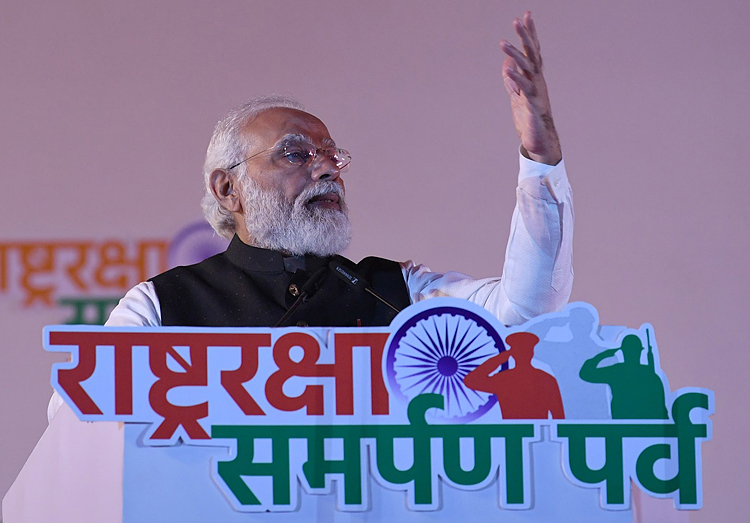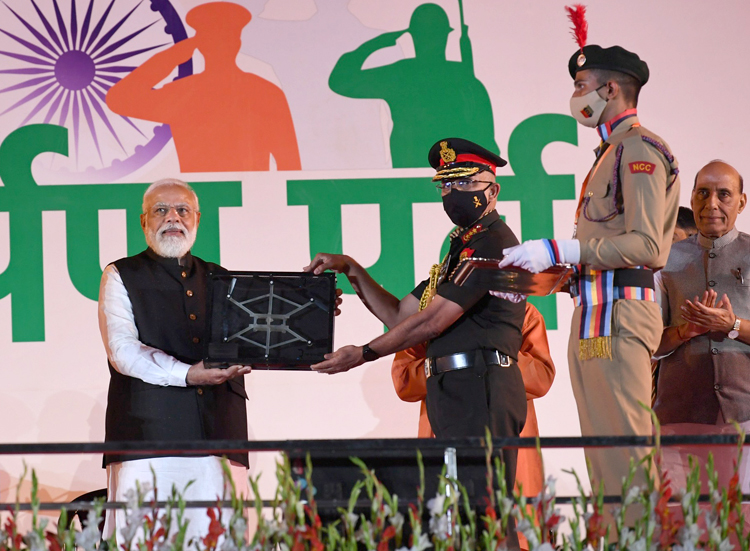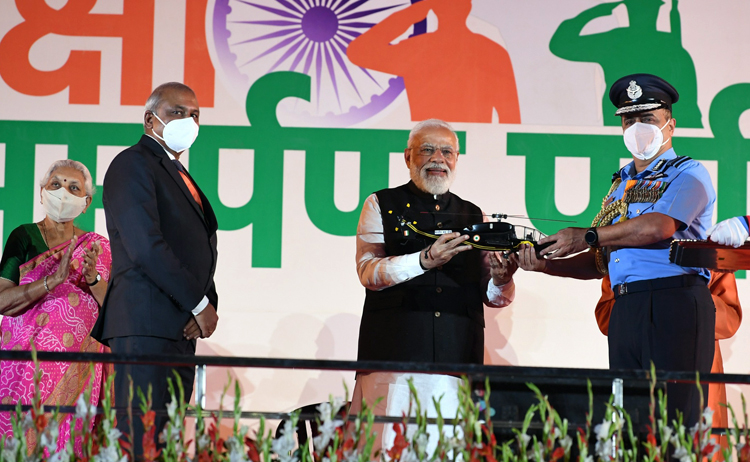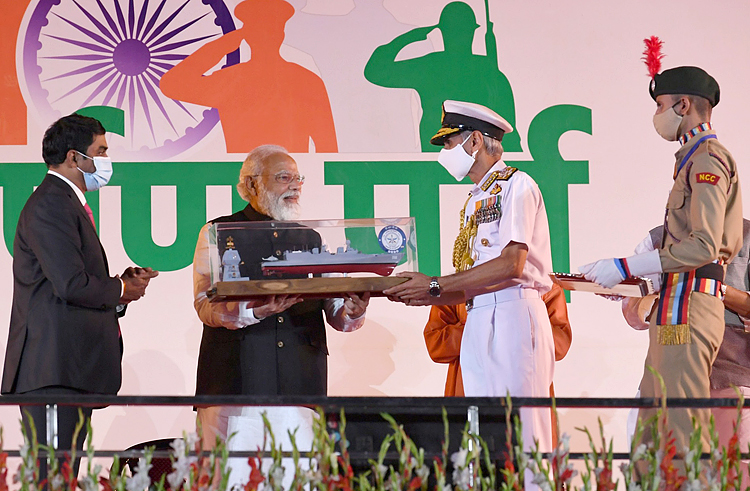INDIAN ARMED FORCES CHIEFS ON OUR RELENTLESS AND FOCUSED PUBLISHING EFFORTS

The insightful articles, inspiring narrations and analytical perspectives presented by the Editorial Team, establish an alluring connect with the reader. My compliments and best wishes to SP Guide Publications.

"Over the past 60 years, the growth of SP Guide Publications has mirrored the rising stature of Indian Navy. Its well-researched and informative magazines on Defence and Aerospace sector have served to shape an educated opinion of our military personnel, policy makers and the public alike. I wish SP's Publication team continued success, fair winds and following seas in all future endeavour!"

Since, its inception in 1964, SP Guide Publications has consistently demonstrated commitment to high-quality journalism in the aerospace and defence sectors, earning a well-deserved reputation as Asia's largest media house in this domain. I wish SP Guide Publications continued success in its pursuit of excellence.
- A leap in Indian aviation: Prime Minister Modi inaugurates Safran's Global MRO Hub in Hyderabad, Calls It a Milestone
- All about HAMMER Smart Precision Guided Weapon in India — “BEL-Safran Collaboration”
- India, Germany deepen defence ties as High Defence Committee charts ambitious plan
- True strategic autonomy will come only when our code is as indigenous as our hardware: Rajnath Singh
- EXCLUSIVE: Manish Kumar Jha speaks with Air Marshal Ashutosh Dixit, Chief of Integrated Defence Staff (CISC) at Headquarters, Integrated Defence Staff (IDS)
- Experts Speak: G20 Summit: A Sign of Global Fracture
Indigenous LCH, Drones and EW Suit
Prime Minister Narendra Modi, speaking on the occasion of 'Rashtra Raksha Samarpan Parv' said, “For a long time, we were a nation that was a weapons and defence equipment buyer. Today the mantra is 'Make in India, Make for the World'.”
 |
The Author is Former Director General of Information Systems and A Special Forces Veteran, Indian Army |

On November 19, 2021, Prime Minister Narendra Modi handed over the indigenously built Light Combat Helicopters (LCH), developed by Hindustan Aeronautics Limited (HAL), to the Chief of the Air Staff, Air Chief Marshal Vivek Ram Chaudhari during the ‘Rashtra Raksha Samarpan Parv’ held in Jhansi, Uttar Pradesh. The Prime Minister also handed over the indigenously developed drones and unarmed aerial vehicles (UAVs) to the Vice Chief of the Army Staff Lt General C.P. Mohanty and the indigenous Advanced Electronic Warfare (EW) suite for naval ships to the then Chief of the Naval Staff, Admiral Karambir Singh. The Advanced EW suite has been developed by the Defence Research and Development Organisation (DRDO) and Bharat Electronics Limited (BEL).

Unlike virtually every other attack helicopter in the world, the biggest designed-in capability of the LCH is high altitude performance, a key requirement from the aircraft users. Prototypes of the helicopter have been successfully tested over the last decade in the super-high altitude areas of Ladakh and the Siachen Glacier. In July 2020, HAL’s chief helicopter test pilot Wing Commander Unni Pillai had said, “We are awaiting contract signature. The delivery of the first 15 LCH can happen almost immediately. We expect a total order for 165 airframes. Looking at foreign market very closely too. Very few countries make a cost-effective attack helicopter — few countries can afford.”
The impetus for the development of the LCH came in wake of the Kargil Conflict that revealed lack of suitably armed helicopters capable of operating unrestricted in high-altitude area (HAA). Hence both HAL and the Indian Military began efforts to define a conceptual combat helicopter for this role.
The LCH which incorporates advanced technologies and stealth features for effective combat roles is expected to boost India’s ability to remain self-reliant
During 2006, HAL announced launching a development program to produce the LCH. The LCH is a derivative of the HAL Dhruv, which was inducted into the Indian Military during the 2000s. Originally, the LCH was anticipated to attain initial operating capability (IOC) by December 2010 but this was somewhat delayed. On January 17, 2019, LCH completed weapons trials with successful firing of Mistral-2 air-to-air missile at a flying target. On August 26, 2017, the then Defence Minister, Nirmala Sitharaman formally inaugurated full-scale production of the LCH.

The LCH which incorporates advanced technologies and stealth features for effective combat roles is expected to boost India’s ability to remain self-reliant. Earlier, Defence Secretary Ajay Kumar said the LCH is the only attack helicopter that can land and take off at an altitude of 5,000 metres with a considerable load of weapons and fuel. As per media reports, the Indian Air Force (IAF) will be LCH’s launch customer though it is the Indian Army that will receive most of the 165 planned LCH. Undoubtedly, the LCH will be an excellent boost for the combat capability of Indian Armed Forces.
The Advanced EW Suit 'Shakti' has been designed and developed by Defence Electronics Research Laboratory (DERL) Hyderabad, a laboratory of DRDO, for capital warships of the Indian Navy for the interception, detection, classification, identification and jamming of conventional and modern radars. The Shakti EW suit will provide an electronic layer of defence against modern radars and anti-ship missiles to ensure electronic dominance and survivability in the maritime battlefield.
The Shakti EW suit will provide an electronic layer of defence against modern radars and anti-ship missiles to ensure electronic dominance and survivability in the maritime battlefield
This system will replace the earlier generation EW Systems of the Indian Navy. The system has been integrated with the wideband Electronic Support Measures (ESM) and Electronic Counter Measure (ECM) for the defence of Indian naval ships against missile attacks. The ESM of the system helps in finding accurate direction and interception of modern radars. The system has a built-in radar fingerprinting and data recording replay feature for post-mission analysis.

The ‘Rashtra Raksha Samarpan Parv’ began on November 17, 2021, as part of ‘Azadi Ka Amrit Mahaotsav’ celebrations. Prime Minister Narendra Modi visited Mahoba and Jhansi districts of Uttar Pradesh in connection with the ‘Rashtra Raksha Samarpan Parv’. Speaking on the occasion he said, “For a long time, we were a nation that was a weapons and defence equipment buyer. Today the mantra is ‘Make in India, Make for the World.’ India is now working to make its Armed Forces self-reliant. These projects will make the nation’s defence sector self-reliant will boost employment opportunities for the youth.”
PM Modi also laid the foundation stone of a Rupees 400-crore project to develop the propulsion system of the anti-tank guided missiles by the Bharat Dynamics Limited (BDL) which is the first project in the Jhansi node of defence industrial corridor created in Uttar Pradesh. He also launched two projects related to the National War Memorial in New Delhi among which was a kiosk that allows visitors to pay floral homage to martyrs through the click of a button.
To support the growth of the defence sector and enhance manufacturing capacity in this sphere, two Defence Industrial Corridors (DIC) are being set up in India, one in Uttar Pradesh and the other in Tamil Nadu.
The success of these two DICs in Uttar Pradesh and Tamil Nadu, coupled with indigenous research and development both in the governmental and defence sectors, will expedite India’s rise as a strong modern military power.





